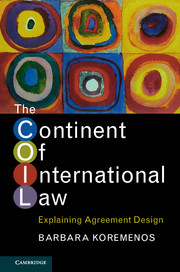Book contents
- Frontmatter
- Dedication
- Contents
- List of figures
- List of tables
- Acknowledgments
- 1 (Re)discovering the continent
- Part I COIL's building blocks: theory and data
- Part II Flexibility provisions in the design of international law
- Part III Centralization, scope, and control provisions in the design of international law
- 7 Dispute resolution provisions
- 8 Punishment provisions
- 9 Monitoring provisions
- 10 Asymmetric design rules, voting, and power
- 11 Conclusion
- Appendix 1 List of agreements in COIL sample
- Appendix 2 Coding rules
- Appendix 3 Selection issues in international cooperation data sets
- References
- Index
11 - Conclusion
from Part III - Centralization, scope, and control provisions in the design of international law
Published online by Cambridge University Press: 05 June 2016
- Frontmatter
- Dedication
- Contents
- List of figures
- List of tables
- Acknowledgments
- 1 (Re)discovering the continent
- Part I COIL's building blocks: theory and data
- Part II Flexibility provisions in the design of international law
- Part III Centralization, scope, and control provisions in the design of international law
- 7 Dispute resolution provisions
- 8 Punishment provisions
- 9 Monitoring provisions
- 10 Asymmetric design rules, voting, and power
- 11 Conclusion
- Appendix 1 List of agreements in COIL sample
- Appendix 2 Coding rules
- Appendix 3 Selection issues in international cooperation data sets
- References
- Index
Summary
I began this book with some simple, yet stunning, numbers about the body of international treaty law now in existence. What can we conclude about this (overall increasing) body of international law? All of the analyses confirm that even though international law is widely varying, it is not wildly varying – that is, it is neither random nor uniform but instead follows identifiable regularities.
When we examine the continent of international law through the game-theoretic lens of the underlying cooperation problems states are trying to resolve, we expect systematic differences across international agreements and institutions. The empirical results confirm that states are shaping agreements in ways that solve their specific problems. As Stein (2008: 212) states: “While it may be difficult analytically to assess the impact of institutions, it remains striking that states use institutions to arrive at the outcomes they want.” Not only do states use institutions; the fact that international agreements obey statistically meaningful regularities in their design indicates that serious efforts are made for them to be able to regulate interactions in lasting and successful ways. So because agreements matter, they are designed in rational ways, and the fact that people make efforts to design them in such ways corroborates their significance.
To elaborate, this book first showcases and explains the non-random, systematic variation in the provisions of international law, including their final clauses, which are not simply copied from one treaty to another as Chapter 5's analyses of withdrawal provisions demonstrate. If these provisions do not matter, why are they not just noisy variation or extremely similar but instead astoundingly systematic in their variation?
Second, the case studies in this book, while they do not constitute the empirical focus, demonstrate that states spend time and energy negotiating the details of international law, suggesting that the details and the law itself are far from marginal in the landscape of international politics. For instance, states were still negotiating the duration provision of the NPT six years after negotiations began. States vehemently debated the right to life provision in the American Convention on Human Rights, which, contrary to Goldsmith and Posner's (2005) argument, is consistent with states taking modern human rights treaties seriously.
- Type
- Chapter
- Information
- The Continent of International LawExplaining Agreement Design, pp. 320 - 345Publisher: Cambridge University PressPrint publication year: 2016



